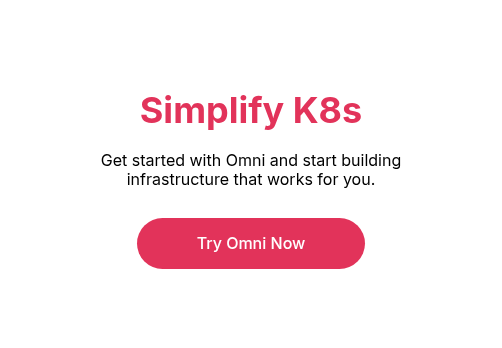Talos Linux is powerful. But do you need more?

Talos Linux is one of the most secure, streamlined methods for using Kubernetes available. It’s immutable, API-driven, and minimal by design. It solves a massive piece of the infrastructure puzzle and can transform the way you do infrastructure almost overnight. Depending on the team’s goals and infrastructure, there will be a varying degree of automation and oversight needed.
Some lifecycle management can be with homegrown automation or Cluster API (CAPI). Others will greatly benefit from implementing Omni, the enterprise-grade interface made specifically for Talos Linux cluster orchestration. We built Omni from scratch to solve several problems that CAPI could not. While the question of lifecycle management can sound complicated, there is a straightforward method to understanding the level of control you need.
Understanding Where You Stand
Start by looking at the number of clusters, the environment, and the team’s overall goals. These topics relate directly to infrastructure complexity and the expectations that surround it. Let’s begin with simple scenarios that do not require dedicated lifecycle management and move toward those that do.
1-2 clusters, usually on managed Kubernetes services like GKE, EKS, or AKS. These are likely fine without any lifecycle automation tooling. If you’re a Talos Linux user and find yourself beginning to outgrow your infrastructure or in need of direction, you can consider Enterprise support. This allows you to get help when you need it without making any large changes to your infrastructure.
At 3-10 clusters, lifecycle management becomes a topic. Teams in this position may already be using custom tooling like shell scripts, Ansible, Terraform, or CI pipelines. This is functional with small or simple deployments but tends to become brittle as the infrastructure grows. You may notice that your environments drift, cluster creation slows, or maintenance costs rise. Once these growing pains start, there’s no going back. Cluster API and similar tools can bridge the gap, but face similar challenges as the infrastructure grows, as updates and reprovisioning are not so simple with CAPI. Omni will become increasingly valuable as a consistent interface to manage infrastructure as it scales in size and complexity.
Platform engineering teams managing clusters for internal developer teams or business units will quickly face the limitations of CAPI. These teams need on-demand clusters that behave predictably without requiring deep Kubernetes expertise from every team. CAPI requires a higher level of Kubernetes expertise than Omni and is not made for mixing and matching compute. Omni is designed to significantly ease the effort required to standardize deployments across environments, manage updates, and provide teams more autonomy.
10+ cluster or hybrid infrastructures spanning cloud, edge, and on-prem will benefit greatly by moving from CAPI to Omni. Maintaining a CAPI provider (eg. AWS, vSphere, OpenStack, etc.) for each environment becomes a major source of operational complexity. Omni excels at this level of scale, as it replaces complexity with a single provider that works across all environments, abstracting infrastructure differences behind a clean, consistent API.
Vendors and service providers offering hosted Kubernetes platforms or on-prem cluster delivery will also greatly benefit from upgrading to a more automated and user-friendly system. For these businesses, the ability to deliver consistent, secure clusters quickly and repeatedly is critical. CAPI lacks the multitenancy controls, secure-by-default provisioning, and fleet-wide observability necessary to achieve this reliably. With Omni, these organizations can reduce setup time, ensure tenant isolation, and roll out infrastructure as a product.
Sometimes, your situation changes. A team that was once managing a single cluster suddenly needs to scale up fast, or environments that were once simple become more complex quarter after quarter. There are any number of forks in the road where your team decides to step back and look again at its tools, priorities, and approach. Choosing Omni means choosing to free up your team, simplifying the work, getting dedicated support, and taking advantage of future product developments. If your team needs that flexibility and control, then you need Omni.
When CAPI Might Not Be Enough
If you’re still unsure, there are certain clear signs that CAPI or manual tooling may not be sustainable. Let’s see if these sound familiar.
You have noteworthy cluster sprawl. You may have started with AWS, then you extended to OpenStack, edge, or bare metal. Each transition adds layers of configuration and risk. When your organization is managing dozens of clusters across different teams or environments, you need a centralized, reliable way to track, provision, and retire them. Talos Linux ensures that individual nodes are consistent. Omni ensures that clusters are consistent, unifying them and enabling you to operate anywhere.
Infrastructure complexity outgrows team size. Talos Linux reduces toil at the node level, but orchestrating many clusters across cloud, edge, and data center environments still takes work. CAPI requires you to operate a Kubernetes cluster just to run its controller stack. For some, this eats up too much team time and takes away from other tasks like working on the product. Omni runs as a single container with no dependencies, making it far easier to adopt, even for small teams.
You need to deliver faster. Many teams need to onboard new workloads, environments, or customers with minimal lead time, and that demands efficiency. Omni provides declarative workflows, version tracking, and centralized management to help teams deliver faster. Plus, Omni is backed by Sidero support. If something breaks or you get stuck, you’re not left alone with Google to figure things out. If you’re on the edge about Omni but still looking for support, you can consider Talos Enterprise Support as a first step.
Here’s more on why we do multi-cluster management without CAPI.
What to Do Next
The best way to evaluate whether Omni is right for you is to try it. Set it up in a test environment and see how much of your provisioning and cluster management process it can replace. Start small by replacing a script, recreating an environment, cloning a production setup into staging, and assessing the time and complexity saved.
You can also get a quick look at Omni and the process of setting up a cluster here.
Never miss an update! Sign up to receive our monthly newsletter.
If you’re not sure what you need next, our team is happy to talk through your current setup and future plans. Sometimes, just knowing what’s possible is the first step toward leveling up your infrastructure. Find a 30-minute slot here.


